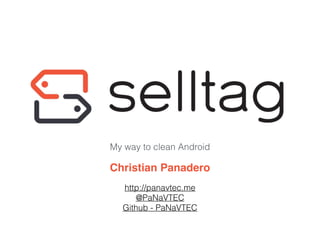
My way to clean android (EN) - Android day salamanca edition
- 1. Christian Panadero http://panavtec.me @PaNaVTEC Github - PaNaVTEC My way to clean Android
- 2. Fernando Cejas Jorge Barroso Pedro Gomez Sergio Rodrigo @fernando_cejas @flipper83 @pedro_g_s @srodrigoDev Android developer @ Sound Cloud Android developer @ Tuenti Cofounder & Android expert @ Karumi Android developer @ Develapps Alberto Moraga Carlos Morera @albertomoraga @CarlosMChica iOS Developer @ Selltag Android Developer @ Viagogo Acknowledgements
- 3. “My way to clean Android”
- 4. Why clean architecture? • Independent of Frameworks • Testable • Independent of UI • Independent of Database • Independent of any external agency
- 5. Concepts • Command pattern (Invoker, command, receiver) • Interactors / Use cases • Abstractions • Data Source • Repository
- 7. The dependency rule Presenters Interactors Entities Repository Data sources UI Abstractions
- 8. Thinking in projects • App (UI, DI and implementation details) • Presentation • Domain y Entities • Repository • Data Sources
- 9. Project dependencies App Presenters Domain Data Entities Repository
- 11. UI: MVP ViewPresenter(s) Model Events Fill the view Actions Actions output
- 12. UI: MVP - View public class MainActivity extends BaseActivity implements MainView { @Inject MainPresenter presenter; @Override protected void onResume() { super.onResume(); presenter.onResume(); } @Override public void onRefresh() { presenter.onRefresh(); }
- 13. UI: MVP - Presenter public class MainPresenter extends Presenter { private MainView mainView; private Bus bus; public void onResume() { bus.register(this); } public void onPause() { bus.unregister(this); } public void onRefresh() { mainView.clearData(); … }
- 14. public interface MainView { void showGetContactsError(); void clearData(); } UI: MVP - Presenter
- 15. Presentation - Domain Presenter InteractorInvoker Bus Bus IMP Invoker IMP
- 16. Presentation - Domain public class MainPresenter extends Presenter { public void onCreate() { interactorInvoker.execute(getContactsInteractor); } public void onEvent(GetContactsEvent event) { if (event.getError() == null) { List<PresentationContact> contacts = event.getContacts(); mainView.refreshContactsList(contacts); } else { mainView.showGetContactsError(); } }
- 17. public class GetContactsInteractor implements Interactor { private Bus bus; private ContactsRepository repository; @Override public void execute() { GetContactsEvent event = new GetContactsEvent(); try { List<Contact> contacts = repository.obtainContacts(); event.setContacts(contacts); } catch (RetrieveContactsException e) { event.setError(e); } bus.post(event); } } Domain - Interactor
- 19. Repository Interface public interface ContactsRepository { List<Contact> obtainContacts() throws CantRetrieveContactsException; Contact obtain(String md5) throws CannotObtainContactException; }
- 20. Repository imp @Override public List<Contact> obtainContacts() throws RetrieveContactsException { List<Contact> contacts = null; try { contacts = bddDataSource.obtainContacts(); } catch (ObtainContactsBddException | InvalidCacheException e) { try { contacts = networkDataSource.obtainContacts(); bddDataSource.persist(contacts); } catch (UnknownObtainContactsException | ContactsNetworkException) { throw new RetrieveContactsException(); } catch (PersistContactsBddException) { e.printStackTrace(); } } return contacts; }
- 21. Data source Model Data source Imp Data source Mapper
- 22. Data source Interface public interface ContactsNetworkDataSource { public List<Contact> obtainContacts() throws ContactsNetworkException, UnknownObtainContactsException; }
- 23. private ContactsApiService apiService; private static final ApiContactMapper mapper = new ApiContactMapper(); @Override public List<Contact> obtainContacts() throws ContactsNetworkException { try { ApiContactsResponse apiContactsResponse = apiService.obtainUsers(100); List<ApiContactResult> results = apiContactsResponse.getResults(); <MAP APICONTACTS TO CONTACTS> return contacts; } catch (Throwable e) { throw new ContactsNetworkException(); } } Data source imp
- 24. Caching Strategy public interface CachingStrategy<T> { boolean isValid(T data); } public TtlCachingStrategy(int ttl, TimeUnit timeUnit) { ttlMillis = timeUnit.toMillis(ttl); } @Override public boolean isValid(T data) { return (data.getPersistedTime() + ttlMillis) > System.currentTimeMillis(); }
- 25. Caching Strategy @Override public List<Contact> obtainContacts() throws ObtainContactsBddException, UnknownObtainContactsException, InvalidCacheException { try { List<BddContact> bddContacts = daoContacts.queryForAll(); if (!cachingStrategy.isValid(bddContacts)) { deleteBddContacts(cachingStrategy.candidatesToPurgue(bddContacts)); throw new InvalidCacheException(); } ArrayList<Contact> contacts = new ArrayList<>(); for (BddContact bddContact : bddContacts) { contacts.add(transformer.transform(bddContact, Contact.class)); } return contacts; } catch (java.sql.SQLException e) { throw new ObtainContactsBddException(); } catch (Throwable e) { throw new UnknownObtainContactsException(); } }
- 26. Repository adavantages • Bussines logic doesn’t know where the data came from • It’s easy to change data source implementation • If you change the data sources implementation the business logic is not altered
- 27. – Uncle Bob “Make implementation details swappable”
- 28. Picasso public interface ImageLoader { public void load(String url, ImageView imageView); public void loadCircular(String url, ImageView imageView); } public class PicassoImageLoader implements ImageLoader { private Picasso picasso; public PicassoImageLoader(Picasso picasso) { this.picasso = picasso; } public void load(String url, ImageView imageView) { picasso.load(url).into(imageView); } @Override public void loadCircular(String url, ImageView imageView) { picasso.load(url).transform(new CircleTransform()).into(imageView); }
- 29. ErrorManager public interface ErrorManager { public void showError(String error); } public class SnackbarErrorManagerImp implements ErrorManager { @Override public void showError(String error) { SnackbarManager.show(Snackbar.with(activity).text(error)); } } public class ToastErrorManagerImp implements ErrorManager { @Override public void showError(String error) { Toast.makeText(activity, error, Toast.LENGTH_LONG).show(); } }
- 30. Tips • ALWAYS Depend upon abstractions, NEVER depend upon concretions • Use a good naming, if there's a class you've created and the naming does not feel right, most probably it is wrong modeled. • Create new shapes using the initial dartboard to ensure that it's placed on the corresponding layer
- 31. – Uncle Bob “Clean code. The last programming language”
- 32. In Uncle Bob we trust
- 33. Show me the code! https://github.com/PaNaVTEC/Clean-Contacts
- 34. References • Fernando Cejas - Clean way • Jorge Barroso - Arquitectura Tuenti • Pedro Gomez - Dependency Injection • Pedro Gomez - Desing patterns • Uncle Bob - The clean architecture
